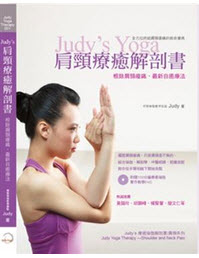又來了,各位同學,令各位又愛又恨的瑜伽醫學原文講義,再度出現在各位的眼前.
不要閃躲,不要害怕,英文並不可怕,可怕的是,根本不看,其實,有看有保佑,難保那一天,閣下您突然大發願心,想要出國提昇自己的專業知識,那麼考取國際瑜伽聯盟(Yoga Alliance)認證必然會成為您的人生目標,其中anatomy(人體解剖學)就是必考項目之一,與其在國外看阿豆那表演,還不如在國內先打好基礎,您說是吧!各位爺們!
為了讓每兩個月的瑜伽醫學研討會,料好實在!才疏學淺的Judy,只好為各位同學上窮碧落下黃泉,搜集許多的專業文章,別小看這本小小的講義,裡面有深度的國外文章,基本的解剖生理學知識,還有從復健及運動醫學切入的專業文章,集結成冊,配合專業的研討會發給各位,就是希望大家的瑜伽醫學功力能提昇.
啊!今天有同學向我反應,講義太難了,我後來才想到,她那天最晚才到,她很不錯,剛下完課,包了台小黃,直奔梵瑜伽,但可惜的是,錯過了先前的基礎醫學的討論,難怪會覺得講義有點難,其實,不瞞你說,專業的文章真的粉難懂,所以才要開研討會,透過Judy本人的搞笑演出,包證讓你心領神會,為了傳逹忠實的知識,上課前還先找醫學博士賴庭瑋醫師,幫我指導一番,否則,好的老師帶你上天堂,壞的老師,帶你下地獄,這可不是鬧著玩,我是個粉嚴謹的人滴!
今天總算將上期的膝蓋研討會的講義寄給對岸的網友苹果,對我而言,瑜伽醫學知識的傳播是很重要的,瑜伽,有太多的流派,每種流派有它不同的教義及規定,因此您必須多嘗試,才能找出適合自己的瑜伽.這讓我不禁想起space專授Mysore老師Gladys,她說:千言萬語,不如一個體會.
看過金庸筆下的神雕俠侶,就知道古墓派的小龍女,輕功了得,內力更是渾厚,不顯於外.若說,Gladys是小龍女再世,真是再適合也不過了.溫柔婉約的她,十分有耐心,常常提醒我,要用呼吸帶領動作.
”不急,瑜伽,就像是一朵花,常練,它就開花了”還記得上幾篇我提到的經典名言吧,就是出自於她的體會.
Paul Dallaghan,是ashtanga派系祖師嫡傳弟子,也是許多人敬仰的偶象,他的體會是什麼呢!他說,
”最偉大的老師,便是練習本身”
只有練習,才能體會,一個體會,勝過長篇大論.
想要體會瑜伽欲死欲仙的奧妙,就來問問練ashtanga的人,尤其是有上過Mysore的人,特別能體會,那種練到全身快虛脫,汗水直流,快要撐不下去卻又不斷跨越自己極限的快感,只有一句話可以形容,置死地而後生,劫後餘生的快樂,當然是筆墨難以形容.當然,想要讓自己更精進,必須要先克服惰性.這也就是我寫持戒的由來.
但突破自我極限,是一個迷思,很吊詭!!也很迷人.
每個人,生來就與眾不同,有人先天骨子軟,有人骨頭硬梆梆,有人不用暖身直接就劈腿,你當他厲害,我為他擔心,有人可以後彎到手抓腳跟,在眾人喝采下,我卻擔心她脊椎關節不穩定,一體總是兩面,柔軟度好,意謂著穩定性差,所以,瑜伽,沒有所謂的標準動作,符合你的生理狀況,盡心去做,就可以了,不是每個人都可以成為David Sweson,也不是每個人都可以逹到腳放頭頂的瑜伽招牌動作.
為什麼,因為你不是他,他也不是你,先天基因,後天環境,以及個人狀況等諸多因素使然,我們必須相信,人是有差異性,也因為如此,每個人才會如此獨特,世界才會如此美好,瑜伽才會如此多元化,記得,老子曾說過一句話,完美的東西,是不存在的,存在的東西,基本上是不完美的,不完美的東西,真的是不完美嗎!錯了,有缺陷的美,才是真的完美.
你懂了嗎,老子真是老子,道可道,非常道,但他還是在出關逃難前,在牛背上,勉為其難地說了出來.
你找到你的瑜伽了沒,不要流於瑜伽名牌化的迷思中,聽聽你身體的聲音,它會告訴你答案,只要你願意停下心來,聆聽.
對了,10月份的瑜伽醫學研討會改時間,感謝林正雄老師的大力支撐,將初級班的時間延後,以利我們辦活動,也讓周六遠從外地來研習班的同學有機會參加,所以,在各方配合下,我們又可以在可愛的星期六辦我們最愛的研討會,大家要報名的話,請在布落格留言,梵瑜伽的妺妹,會幫各位登記下來,人數一樣限制在40人之內,人太多,教學品質會下降,這不是我想要,所以,各位,要報名要快喲!!膝關節的演講講義,我這個禮拜會弄出來,先前MP3有點問題,送修,真不意思,讓各位等太久了.
主題:瑜伽與脊椎側彎
時間:10/21(日)11:00~14:00
地點:梵瑜伽02-82534335
主講:簡文仁理事長(中華民國物理治療全國聯合會理事長)
費用:500元(含講義,我做的講義絕對精彩)
終於決定改成十月的第三個星期六,
11:00~12:00脊椎解剖學課,(教室)
12:00~13:30理事長主講(教室)
13:30~14:00會後討論(在櫃台區討論,不妨礙初級班一點半的課程)
有空大家要記得參加啊,我有買人體模型喲,說不定那天會帶去,如果不會嚇到路人的話.誰有空,將下面的英文翻一下吧.不要偷笑,就是你啦,對,就是每天都會上來晃一下的~~~~~~~~~~~~你 .
.
Yoga for Scoliosis
With regular practice, you can ease the pain of a crooked back and turn it into a powerful teacher.
By Elise Browning Miller
The dull aching on the right side of my mid-back was familiar. Sitting at my desk all day working on income taxes was not only dulling my mind, it was creating a pain in my body that I could no longer ignore. So I got up and headed for the kitchen. Stuffing my face was always a quick solution for the pains and problems of life.
As I grabbed for the food, it occurred to me, "Not only am I in pain, I’m downright depressed! "Though I knew taxes were not always an enlightening task, I hadn’t realized that my whole psyche was besieged by negativity. Was my negative attitude affecting my already vulnerable back or was it the other way around? Either way, eating was not going to solve the problem.
I knew of only one solution for my spasmed back and negative attitude. For years, only yoga had helped me cope with the pain I had lived with almost all my life. At 16 months, I had fallen down a steep flight of basement stairs. Initially, the family physician thought I had only broken my nose. Years later, I found out that my ribs had been knocked out of position from the accident, which gradually created a lateral curvature of the spine called a scoliosis.
What is Scoliosis?
Perhaps the most dramatic of spinal aberrations, scoliosis appears in cave paintings of prehistoric man and was first treated with braces by the Creek physician Hippocrates in the fourth century B.C, Not only does it create spinal deformity and rib displacement, it twists the shoulders and hips and shifts the body’s center of gravity. Its most obvious symptoms are cosmetic, but pain and cardiopulmonary complications (due to compression of the heart and lungs) are also common. The word "scoliosis" is derived from the Greek word skol, which means twists and turns. In scoliosis, the spine forms an S curve (or reversed S) from side to side down the back, and at the same time the back of the spine rotates toward the concave side of the S, twisting the rib cage and making the sides of the back uneven. (To observe this effect, bend a hose into an S shape and observe how it rotates at the same time.) Particularly when this curvature occurs in the mid-back region, the ribs compress on the concave side of the spine and spread apart on the convex side. On the concave side, the attached ribs are pushed sideways and forward, while on the convex side, they collapse toward the spine and move back, thus forming the characteristic rotation of the rib cage. The ribs on the convex side often protrude posteriorly, and over this protrusion there frequently develops a tense, painful mass of muscle tissue.
Four Major Scoliosis Curves
Curvature can take place anywhere in the spinal column but generally follows four common patterns. In a right thoracic scoliosis, the major scoliosis is concentrated in the thoracic (mid-back) region, and the spine curves to the right. (There may also be a counter curve to the left in the lumbar region, but this curve is less severe.) In a left lumbar scoliosis, the major curve is to the left and is concentrated in the lumbar (lower back) region, though, as shown in the diagram, there may be a less extreme counter curve to the right in the thoracic region. A third type of scoliosis is the right thoraco-lumbar, where the major curve is to the right in the thoracic and lumbar region. The last type of curvature is the right thoracic-left lumbar combined curve, where the major curve is to the right in the thoracic region, with an equal counter curve to the left in the lumbar region. For unknown reasons, 90 percent of thoracic and double curves are right convexity (curve to the right); 80 percent of the thoraco-lumbar curves also are right convexity; and 70 percent of the lumbar curves are left convexity. Seven times as many women as men have scoliosis.
Structural and Functional Scoliosis
Scoliosis can be either structural or functional. The structural variety is much more serious and develops as a result of unequal growth of the two sides of the vertebral bodies. It usually appears during adolescence, and its causes are not well understood–approximately 70 percent of all structural scoliosis are idiopathic, meaning doctors do not know why they develop. Functional scoliosis only affects the back muscles and does not structurally alter the body. It can result from such things as poor posture or repeated unbalanced activity, such as always carrying books on one side. It is much more common than structural scoliosis, usually much less noticeable since the degree of curvature is less, and almost always reversible.
To determine whether a scoliosis is functional or structural, bend forward from the hips. If a lateral (side to side) curve visible in standing disappears in this position, the scoliosis is functional; if the curve remains, it is built into the ribs and spine, and the scoliosis is structural.
Yoga or Surgery?
When I was 15, my family physician informed me that I had a severe structural right thoracic scoliosis. He recommended a brace and threatened me with a possible fusion of the spine, an operation in which metal rods are inserted next to the spinal column to prevent the curvature from growing worse. Appalled, I consulted a top orthopedic surgeon, who suggested that instead I try a regimen of exercise and stretching.
I exercised regularly throughout high school and college, but although 1 experienced little discomfort, I noticed that my posture was becoming worse. I was rounding my shoulders, particularly on the right side; and when I wore a bathing suit, I noticed that the right side of my back protruded more than the left. After graduation, while working with the Peace Corps in Brazil, I began to experience spasms and acute pain in my back. Guided by a fellow Peace Corps volunteer, I turned to hatha yoga.
When I stretched in the yoga poses, the numbness on the right side of my, back went away, and the pain started to dissolve. To explore this path further, I returned to the United States, where I studied at the Integral Yoga Institute with Swami Satchidananda and learned about the importance of love, service, and balance in life and yoga practice. Then I turned to the Iyengar system to explore in depth the way the therapeutic use of yoga postures could help my scoliosis.
Since that time, I have been exploring and healing my body through the practice of yoga. By teaching students with scoliosis, I have learned how to assist others with their own explorations. I have found that although every scoliosis is different, there are certain philosophical guidelines and practical yoga postures that can be helpful to yoga students with scoliosis.
To determine whether a scoliosis is functional or structural, bend forward from the hips. If a lateral (side to side) curve visible in standing disappears in this position, the scoliosis is functional; if the curve remains, it is built into the ribs and spine, and the scoliosis is structural.
1. Feet and Iegs. When standing and walking, it is very important to place equal weight on both feet and to be aware of any imbalances. Strengthening the legs creates a solid foundation from which the spine can stretch and become freer, and it enables the legs, rather than the spine, to carry the weight of the body.
2. Spine. Since this is where the scoliosis is located, it is important to focus on lengthening the spine, which tends to reduce the S curve.
3. Psoas (Major and Minor). These two muscles (a pair on each side of the body) are the principal flexors of the thigh. They arise from the iliacus muscle and along the vertebral column and join to insert on the lesser trochanter of the femur. Together with the iliacus, they form a structural and functional unit called the iliopsoas. Besides flexing the thigh, the iliopsoas is an important postural muscle. During sit ting it balances the torso; in standing it counteracts the tendency of the torso to fall behind the line of gravity, which passes just in back of the hip joints. Keeping this muscle well toned aligns the lower limbs with the torso and frees the spine.
4. Scapula. To prevent the upper back from rounding (a common problem in people with scoliosis) , it is important to drop the shoulder blades down from the ears and draw them in toward the front of the body. To facilitate this movement, we must develop increased flexibility of the muscles surrounding the shoulder blades.
5. Abdominal Muscles. To strengthen the abdominal muscles is very important with a scoliosis. If the abdominals are weak, then it causes the back muscles to overwork and therefore tighten. In extreme cases, it may cause lordosis or an extreme curve of the lower back particularly on the concave side of the lower back.
6. Breath. Awareness of the breath is perhaps the most important thing to focus on while doing the yoga poses. Usually very little air enters the lung on the concave side of the spine. Sending the breath into the collapsed rib cage on this side can actually stretch the intercostal muscles and create more lung capacity. This creates more openness and evenness on both sides of the chest, from the inside out.
Read more about this article in Sequences for Scoliosis here.
Elise Miller, M.A. in Therapeutic Recreation from the University of North Carolina, is a Senior Certified Iyengar Yoga teacher from Palo Alto who has been teaching yoga throughout the United States and internationally since 1976. As a founding director of the California Yoga Center in Mountain View, CA, Elise teaches classes and workshops specializing in back care and sports-related injuries and is a faculty member at the Iyengar Yoga Institute of San Francisco. For more detailed information on Yoga for Scoliosis, including Elise’s video, please visit her website at http://www.yogaforscoliosis.com.
[……]
Read more




 瑜伽,也是一樣,有人練了一輩子,都在追求體位法,讓瑜伽變成和體操選手一樣,難度更勝特技表演,瑜伽真正的精髓並沒有進入骨子裡,因此若有一天,體位法不行了,或是被超越了,或是被挑戰了,心中就會激起陣陣波濤,不平,不服,不甘心.
瑜伽,也是一樣,有人練了一輩子,都在追求體位法,讓瑜伽變成和體操選手一樣,難度更勝特技表演,瑜伽真正的精髓並沒有進入骨子裡,因此若有一天,體位法不行了,或是被超越了,或是被挑戰了,心中就會激起陣陣波濤,不平,不服,不甘心.





